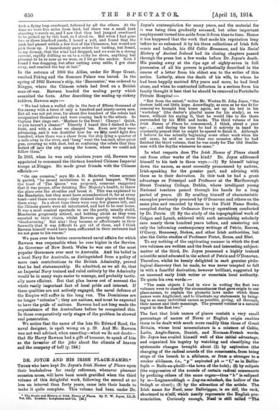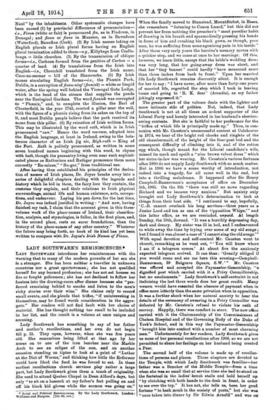DR. JOYCE AND HIS IRISH PLACE-NAMES.* THOSE who have kept
Dr. Joyce's Irish Nantes of Plates upon their bookshelves for ready reference, whenever pleasant occasion arose, will have been much gratified when the third volume of this delightful work, following the second at no less an interval than forty years, came into their hands to Make it quite complete. This volume bad been under Dr.
• Th. Drift& and History of Xrisk Nimes of Places. By P. W. Joyce, LL.D. vol. DI, London g Longman+ and GA RA.] Joyce's contemplation for many years, and the material for it was being then gradually amassed, but other important employment turned him aside from it from time to time. Hence it has happened that the work that made his reputation long- before he so enhanced it by his three collections of Irish folk music and ballads, his Old Celtic' Romances, and his Sociat History of Ancient Ireland had ire doting chapters passed through the press but a few weeks before Dr. Joyce's death. His passing away at the ripe age of eighty-seven in full possession of all his powers is pathetically described in the course of a letter from his eldest son to the writer of this notice. Latterly, since the death of his wife, to whom he had been happily married fifty years and more, he had lived alone, and when he contracted influenza in a serious form his family thought it best that he should be reniovedto Portobello Private Hospita1:— "But from the outset," writes Mr. Weston St. John Joyce, "the doctors held out little hope. Accordingly, as soon as he was fit for removal we brought him home again, set up his bed in his workshop' (the doctor's playful name for his study), as we knew, without his saying it that he would like to die there surrounded by his MSS. and books. The third volume of his Irish Names of Pisces he commenced, I think, about a year ago . . and during the time he had it actively in hand be constantly prayed that he might be spared to finish it. Although I believe he was actually beginning some other work when his call came, he said on more than one occasion after he had finished the third volume, that he was ready for The Old Gentle- man with the Scythe whenever he came."
In what respects does The Irish Names of Places stand out from other works of the kind? Dr. Joyce addressed himself to his task in three ways :—(1) By himself taking down the names, as most correctly pronounced by natives, Irish-speaking for the greater part, and advising with them as to their derivation. In thie task he had a great advantage as Prineipai and Prbfessor at the Harlboroagh Street Training College; Dublin, where intelligent yonng National teachers passed through his hands' for a long period of years. (2) By availing himself of eliarleteriale examples previously procured by O'Donovan and Others on the seine plan and recorded by them in the Field Name Books, compiled during the Ordnancie Survey operationk conducted by Dr. Petrie. (3) By the study of the topographical work of Colgan and Lynch, achieved 'with such astonishing scholarly care nearly three hundred years before, and mastering not only the informing contemporary writings of Petrie, Reeves, O'Curry, Hennessy, Stokes; and other Irish authorities, but also the Celtic( studies of Professor Pieta, 7.reass, and Ebel.
To say nothing of the captivating manner in which the first two volumes are written and the fresh and interesting subject- matter of the third, Dr. Joyce possessed a highly trained scientific mind educated in the school of Petrie and O'Donotan. Therefore. whilst he keenly delighted in each genuine philo- logical discovery that he made, he was never tempted to fall in with a fanciful derivation, however brilliant, suggested by an unsound early Irish writer or uncertain local authority. To quote his own words:— " The main objects I had ih view' in writing the first two volumes were to classify the circumstances that gave origin to our place-names, to explain the phonetic laws under which these names were Anglicized, and to illustrate my statements by bring- ing in as many individual names as pOssible, giving, all through, their names and their meanings. The present volume is a natural sequel to the, first two."
The fact that Irish names of places Obntaift a 'very small percentage of names of Norse or English origin enables them to be dealt With much more readily than those of Great Britain, whose local nomenclature is a- mixture of Oeltie, Latin, Anglo-Saxon, Danish, and Norman-French words. Dr. Joyce has availed himself well of this initial advantage, and organized his inquiry by watching and classifying the systematic changes brought. about (1). by aspiration (the changing of the radical sounds of. the consonants, from being stops of the breath to a. sibilance, or from a stronger to a weaker sibilance, i.e.. "p" aspirated- ph = "f," as in. Bailin, foyle Baile-an-phoill—the town of the hole); (2) by eclipsis (the suppression of the. sounds of certain radical consonants by prefixing others of the same organ--thus "b" is eclipsed by m—Lugnamuddagh = Luteus.m.bodaek the hollow of the bodayh or churl); (3) by the attraction of the artiole. The Irish name for Neal, near Balbriggan, is an diii, the rock; shortened to read& which nearly represents the English pro- nunciation. Curiously enough, Neal is still called "The Natd" by the inha,bitante. Other systematic changes have been caused (1) by provincial differences of pronunciation- i.e., Fiona (white or fair) is pronounced fin, as in Findrum, in Donegal ; and fioun or fiune in Munster, as in Bavrnfonn After having thus established his principles of the deriva- tion of names of Irish places, Dr. Joyce breaks away into a series of delightful chapters dealing with the legends and history which lie hid in them, the fairy lore they contain, the customs they explain, and their relations to Irish physical surroundings, animal life and human existence, arts, occupa- tions, and endeavour. Laying his pen down for the last time, Dr. Joyce was indeed justified in writing "And now, having finished my task, I claim that.the account given in this three- volume work of the place-names of Ireland, their classifica- tion, analysis, and etymologies, is fuller, in the first place, and, in the second place, rests on surer foundations, than the history of the place-namesof any other country." Whatever the future may bring forth, no book of its kind bee yet been written to compare with Dr. Joyce's Irish Names of Places.











































 Previous page
Previous page